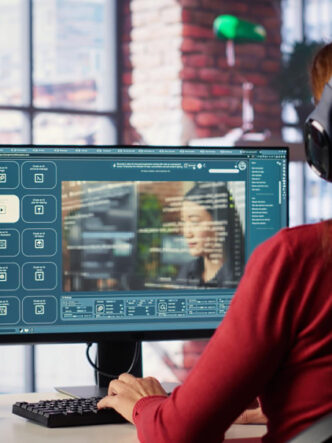Employee training platforms are more important than ever with skill sets changing and more people working remotely than ever before. Staying current with industry practices and building new skills can help to future-proof your organization. Here are ways to maximize your employee training platform to boost employee engagement and increase interaction.

Section 1: Customize learning paths for different employee groups
Traditional approaches to learning aren’t sufficient anymore. Implementing customized learning paths empowers your employees to acquire the necessary skills when they need them. For training to be relevant and engaging, you need to create personalized learning experiences for different roles, departments, and skill levels.
When employees can immediately apply their learning to their current roles and responsibilities, it increases their motivation to learn. They also retain more when they can apply their knowledge straight away.
Personalized learning can address the skills gaps of individual employees. This means that all employees can access training material to help them learn no matter what prior knowledge or experience they have.
When employees take charge of their own learning, they feel a sense of ownership and are more driven to accomplish their goals. They can access training materials at their convenience, from any location, and learn at their own pace. This is particularly helpful for remote employees.
Skills and job requirements are evolving rapidly. Personalized learning makes it easier for your organization to adapt to changing industry needs.
Section 2: Incorporating multimedia content for interactive learning
Using multimedia content makes training more dynamic and interactive. This content can include images, videos, podcasts, infographics, etc. Video tutorials and audio podcasts capture attention more than traditional text-based materials. Here are some training engagement strategies.
When you incorporate multimedia, it must align with your learning objectives. Actively having to complete objectives can increase employee motivation and reduce distractions. For example, videos can feature real-life scenarios where employees have to find solutions. Podcasts can feature discussions with industry experts about important topics.
With real-time feedback employees can understand their strengths and where they need to improve. They can make adjustments and see the impact of their efforts.
It’s helpful to provide multiple forms of the same content to reinforce learning. For example, you can offer transcriptions and audio descriptions. Creating multimedia playlists allows learners to navigate through different content types.
Live streaming video content allows for interaction in real time. You can create a collaborative learning environment where viewers can ask questions, participate in polls, and share opinions. You can answer questions, respond to comments, and make suggestions.
Cincopa’s multimedia capabilities make creating interactive learning experiences easy. You can customize high-quality multimedia content to meet the unique requirements of your business.
When using the Cincopa video hosting platform your training programs will offer easily accessible and seamless learning. Your employees won’t experience technical issues relating to device compatibility or video buffering that could disrupt learner access and engagement.
You will be able to easily live stream video content and then save it as video-on-demand in a video library. A video library offers employees access to videos at any time when it suits them to improve their skills. They can easily search for and find the content they want.
The customization options Cincopa offers allow you to accommodate the diverse needs of your workforce. For example, you can use subtitles to accommodate speakers of different languages and help those with hearing problems.

Section 3: Gamification and quizzes to boost engagement
Incorporating game design elements and principles into training programs can enhance employee engagement and help them to retain more. These elements include badges, leaderboards, and quizzes. The idea is to learn while having fun and for employees to challenge themselves and achieve specific goals. Gamification leverages the psychology of reward-based learning. It gives employees more choice and control over their learning journey. Some key features of gamification include:
- Goals
- In-lesson or post-lesson game elements
- Competitive elements
- Rewards
- Scoreboards
Defining goals makes it easier to track progress. In-lesson game elements may include brief quizzes or interactive role-playing. A post-lesson element could be a cumulative quiz. Points, badges, and leaderboards allow for some friendly competition and motivate employees to complete training to the best of their abilities. More tangible rewards can also give employees incentives to complete lessons. Scorecards can display details about the performance of different employees and make it easier to see how they are progressing.
Gamification strategies can encourage collaboration and social interaction. Through collaborative challenges and group tasks, employees develop more of a sense of community which promotes team building and knowledge sharing.
When you group employees by department and measure their progress as a unit, they are motivated to work together as a team to achieve success.
The reward system helps employees to enjoy the learning process and they are more likely to keep up with lessons and retain information.
Training areas where gamification is useful: Using game design elements is helpful in many different training areas, such as in onboarding new employees. They could complete quests or challenges as they learn about the company culture, policies, etc.
In compliance training, they could earn badges or points for correctly navigating certain scenarios in videos relating to legal or ethical dilemmas. The same could apply to health and safety training.
When acquiring new skills, employees could progress through a series of levels or milestones. They could earn certifications or badges on completion of the highest level.
In product knowledge training, employees could earn points for correctly completing quiz questions about the features or benefits of a product.
Section 4: Tracking engagement metrics
Tracking engagement metrics is crucial. Metrics may include watch time, completion rates, quiz results, and time spent on modules.
Embed interactive quizzes, feedback forms, and assessments seamlessly within video and audio content can give you real-time insights into employee progress.
Visit Cincopa’s home page and you can find out more about its detailed analytics to track learner engagement with content. Every video view generates a video heatmap that shows viewer behavior while engaging with training videos. White, green, and red colors reveal the level of interaction. You can find out whether learners skip certain parts, rewatch others, and where they drop off. If they skip certain parts, you can consider leaving these parts out. If they drop off it could be because you need to reduce the length of the video.
Section 5: Continuous feedback and improvement
It’s important to establish regular feedback loops to ensure that employees can keep offering their insights about training content. HR learning and development teams can keep refining and enhancing training programs with these helpful insights. For example, there may be a need to break learning content down into smaller, topic-specific modules. Modules may need to be modified to directly address certain skills gaps. Continuous improvements will help create relevant and personalized learning journeys that address each employee’s unique needs.
Conclusion
Cincopa’s platform can help you maximize training program engagement in various ways. You can personalize learning paths, gamify content, and use multimedia content for more interaction. You also have in-depth analytics to assess progress and discover how to improve your training materials.








